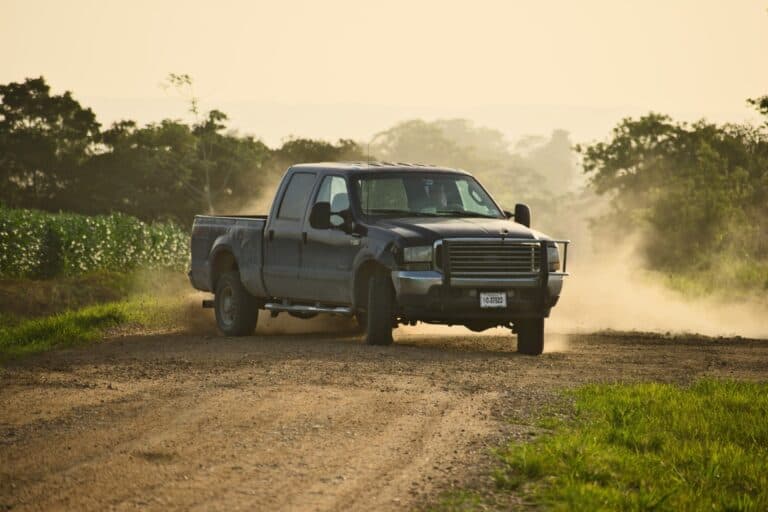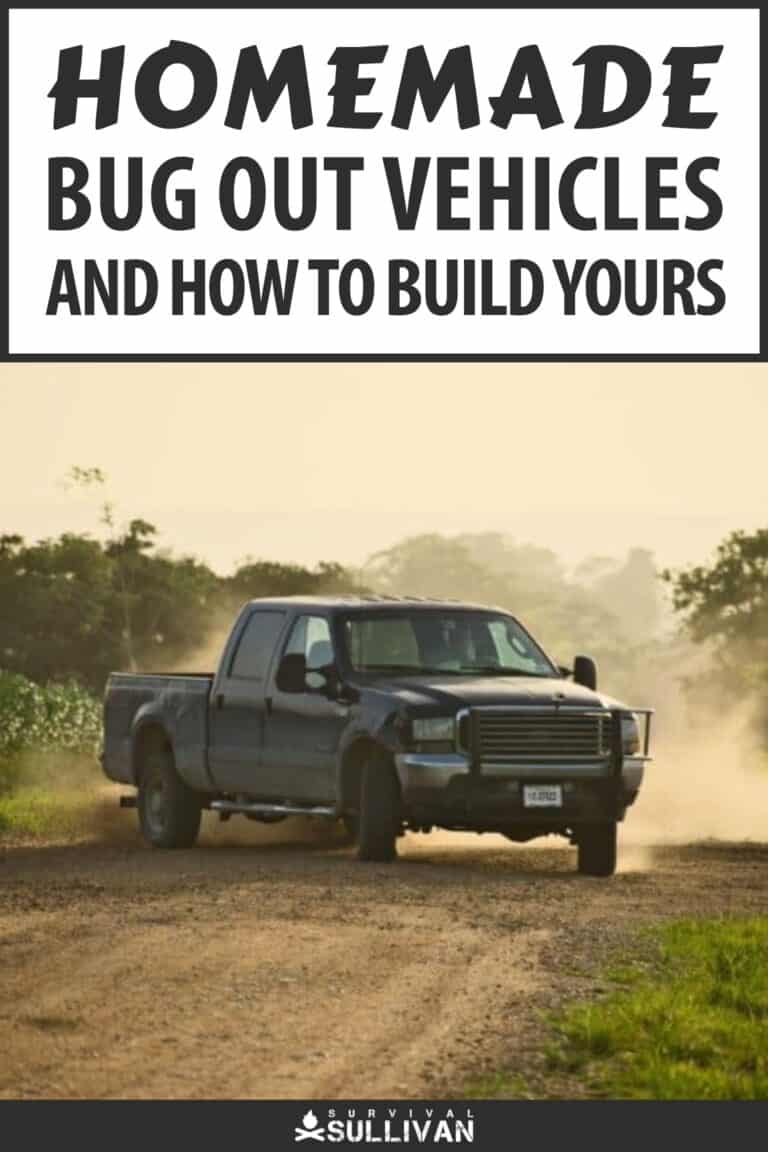One of the most central concepts to prepping is bugging out. When you can’t stay put and bug in, it’s time to grab your gear and literally head for safer pastures.
But, as iconic as the image of hiking out on foot is, that isn’t the best way to go. If you want to carry as much gear as possible, and get away from danger quickly, you’ll need a vehicle.

That’s where a bug-out vehicle, or BOV, comes in. Your bug-out vehicle can get you where you need to go quickly while carrying more gear and saving you from a grueling and dangerous journey on foot.
And you don’t need some wasteland war rig, either; most common vehicles can do just fine with a little bit of know-how and some smart upgrades.
Keep reading, and I’ll tell you how to build out your own bug-out vehicle.
What is a Bug-out Vehicle?
A bug-out vehicle, or BOV, is exactly what you were expecting: a vehicle designed to help you complete a bug-out.
Whether you are heading to a distant bug-out location (BOL), want maximum speed or greatly improved carrying capacity over what you can haul on your back, a bug-out vehicle is just the ticket.
What Kinds of Vehicles Can Be BOVs?
Contrary to the popular conception, pretty much any roadworthy vehicle can be a bug-out vehicle depending on your plan and the circumstances you find yourself in.
I know that most of us guys, at least, dream of huge jacked-up pickup trucks or SUVs, or maybe an armored car that is suitable for cutting a swath through teeming rioters, but a bug-out vehicle doesn’t have to be anything quite so romantic or fantastical.
In fact, whatever your daily driver is, it is probably suitable as a bug-out vehicle. If it can get you where you need to go quickly, carry a little bit of extra gear and is reliable, you’re in business.
Add a few smart upgrades and you’ll have a capable, and just as importantly, stealthy bug-out vehicle to depend on when the chips are down.
Consider the following vehicle types as the basis to build your bug-out vehicle, but these aren’t the only types that are worthwhile!
1. Cars
Cars are common, fit in pretty much every sector of society and offer a good compromise between passenger capacity, cargo capacity and fuel mileage.
Most types only have meager off-road capability unless specially designed or upgraded, however.
2. Pickup Trucks
Pickup trucks are great for carrying massive amounts of cargo, and depending on the size of the cab they still have room for the whole family or a small group.
Most are also decent to highly capable off-road, too. However, fuel mileage tends to be very poor, and protecting cargo in the open bed is a full-time job.
[TAG1]
3. SUV
Basically a cross between a car and a truck. Ample passenger room and respectable cargo capacity, easily expandable with rooftop racks.
Enclosed cargo bay offers better protection than truck bed. True SUVs typically have modest to good off-road performance. They also tend to be gas hogs, however.
4. Motorcycles
A motorcycle might seem like a death wish at first glance, but they have distinct advantages.
Motorcycles easily fit and squeeze through where cars simply cannot go, they sip gas by comparison, but obviously limitations are cargo capacity and a lack of protection for the rider, both from weather and from people.
5. Bicycles
Bicycles have many of the same advantages as motorcycles, with the added advantage of being easy to carry themselves for crossing impassable terrain.
Only limited and range by the endurance and fitness of the rider. Very quiet. Cargo capacity sharply limited.
6. RVs
At first glance, RVs seem to be the ideal bug-out vehicle. A literal rolling, self-contained home away from home.
They can be that, and they have significant cargo capacity, but these are behemoth vehicles that are difficult to maneuver, easily caught in traffic and very easy to bog down when off-road.
Can be a good option, but highly situational.
Which vehicle you choose depends on what you have access to and also the situation you are anticipating.
If you are planning to bolt out of a densely populated urban area, you must anticipate total gridlock traffic in all directions that will stop most automobiles cold.
A motorcycle might be able to slip out, or a bicycle certainly.
If you already live in a remote, rural area where there aren’t many people, an RV might still be a great choice.
This is because you can leave your home behind and not worry about too much traffic wherever you happen to be heading, making its advantages far more attractive against its disadvantages.
Give this some thought, use common sense and choose recording, but in any case, you can always make the most of your daily driver, so keep reading.
What Kind of Terrain Does Your BOV Need to Handle?
Ideally, your bug-out vehicle should have some off-road capability. But once again, in my opinion this is somewhat overstated.
It all depends on where your bug-out location is; if it is on a remote mountainside that is only nominally traversable via logging roads in good weather conditions, you’d better have a seriously capable off-road rig.
On the other hand, if you’re just trying to go down the turnpike a-ways before heading to your cabin along a nice gravel road or driveway, you probably won’t need a ton of off-road capability.
It’s good if your vehicle is confident or at least passable if you have to jump off the shoulder and drive around an obstacle, or potentially make a reasonable overland shortcut.
But keep in mind that even in the best vehicle and relatively well-known conditions, it is very easy to get stuck or break down when going off road.
Generally speaking, I recommend a few strategic upgrades to this purpose: all-terrain tires for your daily driver should be considered mandatory, and depending on where you live and what you are planning consider a modest suspension upgrade to help you cope with uneven and rough off-road terrain.
If you already have an SUV or a truck, consider a suspension upgrade or lift that will allow you to drive straight over smaller downed trees that might be blocking the road.
Upgrading Your Bug-Out Vehicle
What are some other upgrades you should consider for your bug-out vehicle? I don’t like to go too crazy here unless budget is absolutely no object.
Extra Cargo Capacity
I always, always recommend expanded cargo capability: The more gear you can take with you the better off you’ll be, and the more comfortable you’ll be when you get to your bug out location.
For SUVs, most cars and some trucks, you can fit roof racks that will allow you to stash containers or loose cargo.
Even bicycles and motorcycles can be fitted with small boxes and bins to carry a little bit of extra cargo.
Be sure to invest in heavy duty tie-down straps or cargo nets to keep your stuff from flying off!
Durability and Reliability Upgrades
After this, it’s all about durability and longevity. If your vehicle has any known weak points or parts that are prone to break down, either upgrade them with superior OEM or aftermarket versions.
Consider a larger fuel tank for greater range. An upgraded battery and an inverter can allow you to run small appliances and recharge electronics using your vehicle alone.
Depending on your preferences, investing in run-flat tires might be a great hedge against getting a flat that could sideline you when you could least afford it.
Winch (Optional)
If your vehicle can mount it, a winch is a lifesaver when you get stuck or you need to remove an obstacle from the road.
But you must take the time to learn how to use it effectively and safely, and understand that they are always a target for theft.
Keep it smart: huge lift kits, massive brush guards, and aggressive-looking but ultimately cosmetic fenders, bumpers and the like are wonderful for the ego, but they don’t do anything for you in most situations and they definitely attract the wrong kind of attention.
What Supplies Should You Keep in or with Your BOV?
Your bug-out vehicle needs supplies of its own to fulfill your mission, in addition to your bug out bag and any other gear and provisions you plan on bringing with you…
Consider the following items mandatory inclusions for any well-equipped bug-out vehicle:
1. Spare Tire
The importance of a spare tire should be obvious. It doesn’t avoid the need for the next item on this list, but nothing is better for getting you back on the road quickly when you have a flat.
Fix the flat later at your own convenience.
2. Tire Repair/Inflation Kit
Sometimes you’ll have multiple flat tires, or you’ll just need to repair the flat tire when you get to your destination or to your waypoint.
You should have various patches, a can of flat-fixer, and an air pump that can be powered by your vehicle’s outlets.
3. Jumper Cables
Another obvious inclusion for your automotive preparedness kit.
It’s good to assume that you’ll be able to take care of everything yourself, but if you’re traveling as one vehicle in a convoy this makes perfect sense.
4. Jump Box
Used to jump a vehicle with a weak battery when there are no other vehicles around. Keep it charged, and make sure you verify its performance periodically.
5. Duct Tape
Duct tape can fix anything, including a badly busted car. Perfect for holding together a smashed windshield or rattling body work after a collision.
6. Paracord
Paracord and a good working knowledge of knots like the trucker’s hitch can help you secure cargo, make improvised repairs, and do a whole lot more while you’re on the road.
7. Tow Straps
You can use tow straps with a farm jack, next, or another vehicle to recover a vehicle that is stuck, or move some obstacles out of the road. No winch required.
8. Farm Jack (space allowing)
A farm jack, also called a high-lift jack, is a powerful tool. You’ll need it if you have a larger lifted truck or SUV, but it can also be used as a come along, as a spreader and has a manual winch.
Large, bulky, and long, so leave this out if you don’t have the room and don’t want to secure it to the outside of your vehicle.
9. Window Breaker
Under the circumstances, the chances of an accident are high.
You can use a window breaker conveniently clipped to your seatbelt or secured within reach in the cabin to bust a window and get out if your door won’t open.
10. Seat Belt Cutter
Same thing here. If your seatbelt gets jammed or the latch just isn’t accessible after a crash, a seatbelt cutter can it free you from a potentially deadly restraint in the blink of an eye.
11. Maps
You have to know where you are going, and even if you know the route by heart things might look very different in the middle of an SHTF situation.
Consider also that you might be forced to detour.
12. Compass
GPS is great, but you might not be able to trust it when the chips are really down. A good, analog vehicle-rated compass will always let you know which direction you are heading.

The post Homemade Bug Out Vehicles, and How To Build Yours appeared first on Survival Sullivan.
By: Tom Marlowe
Title: Homemade Bug Out Vehicles, and How To Build Yours
Sourced From: www.survivalsullivan.com/homemade-bug-out-vehicles/
Published Date: Fri, 18 Aug 2023 16:00:00 +0000
------------------------
Did you miss our previous article...
https://bushcrafttips.com/bushcraft-news/what-if-youre-stranded-on-a-flooded-jeep-trail
 What is BushcraftSurvival SkillsToolsVideosBushcraft CampsBushcraft KitsBushcraft ProjectsPrivacy PolicyTerms And Conditions
What is BushcraftSurvival SkillsToolsVideosBushcraft CampsBushcraft KitsBushcraft ProjectsPrivacy PolicyTerms And Conditions
